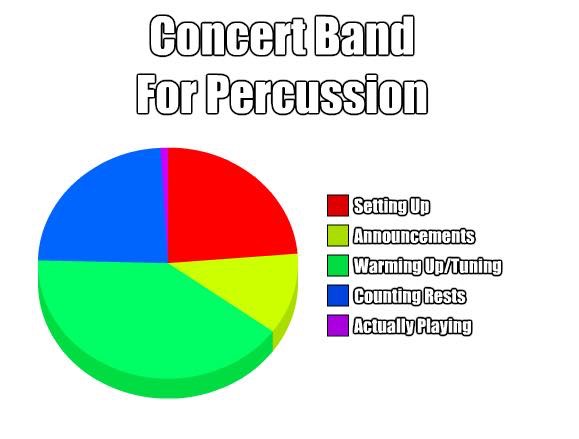Everything I mention here could probably be its own blog post (and I may do that sometime in the future), but in the meantime - as many directors are embarking on planning out their spring programs this time of year - I thought it was a good time to share this little rant with the world…
~~~~~~~~~~~~~~~~~~
The phrase “playing with the band” can be a dirty set of words for young percussionists. Band parts are, as a general rule, not pedagogically developmental (and therefore not interesting) for the developing percussionist, so it’s understandable if they sometimes don’t enjoy… or they dread… spending time with the band.
The last couple of years I’ve observed a growing trend with band directors of spending a great deal of curricular time playing concert music at a very slow tempo (50% of performance tempo or less), or in very small chunks (4-8 bars), in order to work detail with wind performers during the initial learning process. While I’m not a wind player and have never taught winds, I can appreciate that this process allows for a lot of attention to detail and a high level of success with technical challenges that are still in the developmental stage – just like learning a really hard marimba solo.
However, for percussionists, who are playing parts that generally are not so challenging, or who play only infrequently (think of your average bass drummer or cymbal player, who maybe gets to play three notes every 8 bars), this process is not only boring… REALLY boring… it’s counterproductive. Super slow tempos, small chunks, etc., allow young percussionists to fall in the trap of practicing things that won’t work in the long run – stickings, set-ups/mallet changes, or different techniques (ex. diddling faster passages instead of single sticking). Plus they lose the opportunity to hear how their parts fit with the band, what the scope of the piece is, and how fast their brains will have to move in order to count and come in, play here and not there, shape the dynamics appropriately, balance to the ensemble (the dynamics on the page can be deceptive depending on the size of your ensemble and factors like the size of your instruments and implements), etc.
In short, young percussionists need to get a sense of the piece early on in the learning process, and there is no replacement for doing that with their other fellow musicians in the band, rather than with a recording or something similar. Young wind players also need a chance to get a sense of the scope of a piece so that they can accurately deal with issues like breathing, register changes, page turns, etc.; so spending some time early on running larger chunks at faster tempos (ideally 70-80% performance tempo, minimum) will help those young musicians too.
I get it – you need to work on breathing and intonation. You need to tune the piccolo to the flutes and help the horns jump between partials. Ideally, you should be doing most of those things in sectionals. Also, in a perfect world, your percussionists are receiving percussion-specific instruction in another room at least a couple days a week, which is the perfect time for you to dig into wind issues. If you’re not lucky enough to have that opportunity, then at least give your percussionists alternate assignments on the class days where your lesson plan involves more wind detail work; please, please, please do NOT expect them to sit in the back of the room doing nothing for long stretches of time - they (like all students) deserve to participate.
A note on metronome usage: Turn the metronome off sooner than the week of the concert! (Not only percussionists need this…) Constant metronome use fosters tempo dependence and reliance on the beep instead of the conductor. If you want your young musicians to watch, they have to practice this skill. And if you’re going to use the metronome, make sure the sound comes from the back of the room. This may require you to move speakers and run cords through your set-up, but it’s how physics works – musicians CAN’T “listen forward” and still play with the met.
And speaking of tempo - please don’t wait till the week before the concert to increase the tempo. Percussion performers may need to make sticking changes, set-up changes, or technique alternations to be successful at quicker tempos. When you wait till the last second to go “the real speed,” you rob them of the opportunity to practice correct execution.
Last but not least – one of my biggest pet peeves: speak to your percussionists like they’re musicians. If you don’t like the sound they’re making, say so. Use descriptors like “harsh,” “tight,” “resonant,” “dark,” etc., just like you would with any other musician in your band hall. If it’s clear that a percussionist is having a technique issue that’s leading to incorrect or unmusical execution of a part, and you don’t know the answer off the top of your head, make a point to ask a percussionist for help and meet with that student later to pass on the information. Don’t be afraid to give feedback to your percussionists, the same as you would any other musician!
TL;DR: play more music sooner!

